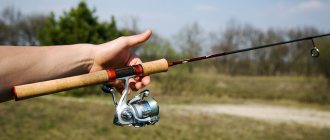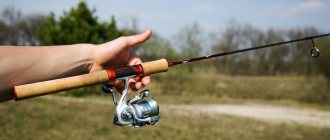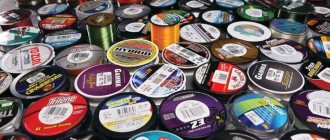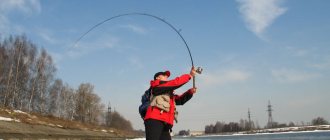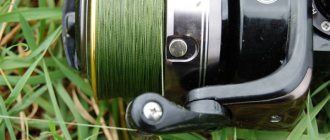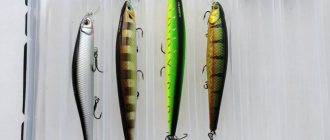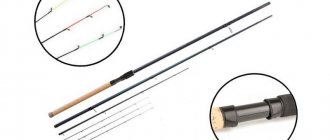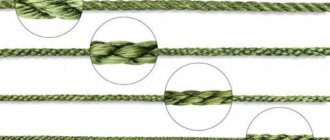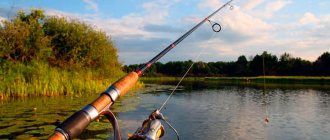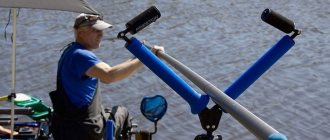Fishing Rods Review
February 16
Review of fishing rods (types and selection of fishing rods)
Fishing is one of the favorite leisure activities of men and women. Fishing is a business, obtaining food, and also just a pleasant pastime. You can fish everywhere, in the sea, in a river, in a lake. The main thing is to have the right gear with you at the right time. Or prepare in advance and think through all possible fishing options. The effectiveness and pleasure received while fishing depends on the choice of suitable gear.
Spinning rod or fishing rod? Some people only like fishing rods, others prefer spinning fishing. There are those who love both types of fishing. A fishing rod is a traditional type of fishing; usually it is with it that a fisherman begins his journey in learning about fishing gear. There are now many different fishing rods available for different purposes. Some of them have a narrow focus, others are more universal.
Types of rod designs
By design, all fishing rods can be divided into 3 types:
1. Telescopic. These fishing rods are very popular among fishermen for their compactness. They are suitable for different types of fishing. “Telescopes” are retractable fishing rods. Due to the large number of connecting nodes, telescopic fishing rods have more weight compared to other types of fishing rods. Also, experienced fishermen are less durable during operation. Their advantage is their small size, which simplifies the problem of transporting the rod to the fishing spot. When buying a telescopic fishing rod, it is important to make sure that the connecting parts are of good quality.
2. Plug fishing rods. Rods of this type are considered a class higher than telescopic fishing rods. They are durable, but at the same time have good bite sensitivity. These folding fishing rods are often two-armed, but there are also options consisting of three arms. Plug-type fishing rods are considered reliable, light in weight and have good ergonomics. Most of them are made from high-quality raw materials, which ensures their excellent performance.
3. Monoblank rods (“mono” - one). These rod models have only one component. They are quite rare and are used mainly for winter fishing and fly fishing. Some elite ultra-light class rods are mono blank. Monoblanks are specialized fishing rods and do not have universal characteristics. Single-leg fishing rods are not easy to transport; they are quite difficult to transport due to their length. Monoblanks are good to use when you can take a fishing rod and walk to the reservoir. A big plus of such fishing rods is their ability to withstand even the largest fish due to their design.
Each angler has his own preferences for fishing rod design based on fishing conditions.
Choosing a fishing rod for summer fishing
At first glance, choosing a fishing rod does not present any particular difficulties. But, having come to the store, a novice fisherman sometimes gets lost among the variety of models presented. In order to make a decision faster, come to the store prepared. There are certain criteria by which fishing rods are selected:
1. Study the characteristics of the reservoir: depth, size, possible current. If the water is still, you will need one type of fishing rod; if the water is fast, completely different ones will be needed.
2. When going fishing, it is better to have an idea of what kind of fish is found in the reservoir. The size of the fish determines the choice of gear and its characteristics: action, test, length.
3. An important criterion for choosing a fishing rod is the method of fishing - from the shore or from a boat. As a rule, when fishing from a boat, shorter rods are required, while from the shore, longer rods are required.
All fishing rods have common components:
1. The “stick” itself calls the form.
2. Komel. Stiff part with handle.
3. The whip is exactly that part of the fishing rod that the angler casts.
4. Nod - the tip of the fishing rod, which gives a signal about a bite.
5. Passing rings. Located on the form for attaching the fishing line.
6. Reel (with fishing line).
7. Hook.
8. Bait.
9. Float.
In addition to common characteristics, fishing rods have many differences. There are several different types of fishing rods: float, fly, feeder, fly, spinning.
Float rod
The most “ancient” method of fishing. Almost all anglers started fishing with the float. But times change, and so do fishing rod designs. Today we can distinguish 4 types of “floats”:
Fly rod
. The simplest fishing rod in its design. The fly rod is a “telescope” up to 10 meters long. At the end of the form there is a connector to which the fishing line is attached. The fishing rod does not have guide rings or a reel mount. The raw materials from which the forms are made are carbon or fiberglass. To fish out a particularly large predator, a small piece of durable rubber can first be attached. The basic requirements for fly rods: they must be light, so that the angler’s hand does not get tired from frequent casting, and the rod must lie comfortably in the hand (not slip). The advantages of such fishing rods include:
1. Lightness.
2. Simple equipment.
3. The versatility of the rod. Fly fishing rods are suitable for use with different fishing methods. They are also used to catch different types of fish.
4. Elimination of snags and tangling of fishing line (in extreme cases).
5. Simplicity of fishing technique. Suitable for novice anglers.
Bolognese fishing rod
. This type of “float” can be of a telescopic or plug-in design. These fishing rods are equipped with guide rings and a reel for fishing line. Compared to a fly rod, Bolognese tackle allows you to make long casts and catch fish of different sizes.
Plug fishing rods.
The design of the fishing rod consists of a whale and plug components. The essence of the whale is a “telescope stick” with an elastic band threaded through it. The whale is placed into plug segments. Their length can reach 16-20 meters. The plugs have a “blind” type of equipment. In this case the bait is not cast. The fisherman pulls out the fishing rod and the bait ends up at the fishing spot. Plug fishing rods are light in weight and up to 10 meters long. With this fishing rod you can catch and hook different types of fish.
Match fishing rod
- another type of float rod. A match fishing rod consists of a blank, a reel (spinless), monofilament and sliding equipment. These fishing rods are designed for catching cautious fish that do not venture close to the shore. Their length reaches from 3.5 to 5 meters, the raw material is carbon fiber. Among fishermen, match rods are considered a complex rod, fishing for which requires certain skills and abilities. When using match rods, you need to be able to combine the reel and blank and make accurate casts.
All float rods can have a “blind” or “running” rig. In the first case, the hook is fixed, in the second it slides between the stoppers.
Choosing a fishing method
Spinning fishing
This type of fishing is very exciting and gives a good catch. The main thing is to learn how to properly control the spinning rod. It will take quite a lot of time to improve your skills. You may spend one fishing season learning the techniques and tactics of working with a spinning rod, but all your efforts will return a hundredfold. And catching, for example, pike perch with silicone baits will no longer seem like a fairy tale.
First of all, pay attention to the casting force (use 1/3 of your heroic power) and its range (vary the force and angle of the cast). There are a lot of exercises that will help you develop these skills and enjoy the results. Explore our section on spinning.
Float fishing with a fly rod
Why do many fishing enthusiasts choose a fly rod? The answer is simple - this tackle is universal and suitable for almost any fishing conditions. There are no unnecessary parts that could cause inconvenience to the fisherman. The equipment and structure of the fly rod are very simple.
The casting technique is simple and does not require the participation of a reel; there is no reel in this fishing rod at all.
A number of advantages of a fly rod:
- reasonable price;
- simplicity of the device, understandable even for beginners;
- simplicity of fishing technique;
- high probability of catch in any body of water, both white fish and predators can bite;
Thanks to these characteristics, this fishing rod has won many fans among fishing enthusiasts.
Feeder fishing
This fishing method can scare off novice anglers due to some nuances. Let's figure out what it is. Feeder fishing is a modern version of bottom tackle. The main difference between the feeder and the prototype is the presence of a rod with a sensitive tip, which is designed to signal the beginning of a bite.
The tackle is also equipped with a feeder, which attracts fish to the baited hook. You can cast this feeder up to 100-120 meters from the shore thanks to the powerful feeder rods and reels.
And this is a great way to catch shy deep fish. The advantage of feeder fishing is that the angler can sit in a convenient place and enjoy nature and relaxation. This happens thanks to the feeder - you don’t need to move around the reservoir in search of fish, you just have to remember to regularly send food to the fishing spot. Once you understand the intricacies of bait and the types of rods, feeder fishing will become a dynamic and unexpected outdoor sport for you.
How to choose the right spinning reel grinder - criteria for assessing the most important components of a reel for spinning, feeder and float fishing.
We looked at how to choose telescopic spinning rods in this article.
We choose the right fishing line once and for all for each fishing method.
Feeder rod
A feeder rod is a tackle for bottom fishing. Such fishing rods are equipped with a special bait feeder (feeder). The fisherman throws the feeder into the pond, feeding the fish. Further fishing takes place at this baited place. Feeder fishing is similar to spinning fishing. They differ in the presence of a sensitive tip on the feeder rod (quivertip). This part of the fishing rod can be changed depending on the size of the load being cast. The quivertip is a bite alarm. Also, the difference between a feeder rod and a spinning rod is the large number of guide rings (at the feeder). In some models there can be up to 20 pieces. The feeder rod kit includes:
1. Form;
2. Fishing line (it is better to use braided);
3. Inertia-free coil;
4. Leash, hook;
5. Bait feeder.
Advantages of feeder fishing rods:
Feeder fishing is designed for catching bottom species of fish. As you know, a large predator prefers to take bait from the bottom. This means that there is an opportunity to catch good specimens on the feeder. The sensitive tip helps to catch even the weakest fish bite. This type of fishing allows you to fish from the shore, precisely throwing a fishing rod into a body of water.
Build and test
Some anglers may be surprised, but float rods, just like spinning rods, have an action. This significant parameter primarily refers to the rigidity of the product. In fast action models, only one upper knee (the tip) bends; in medium-fast action, the working part is the two upper knees; in medium-fast action, about half of the rod bends; and slow action is a characteristic of a “stick” that can bend to the shape of a ring. In this design, only the butt knee remains straight. How does formation affect fishing? Highly rigid (fast) rods cannot soften the desperate resistance of a large, strong fish, so they are designed exclusively for catching small fish or in tandem with a reel to transfer the main load to this element. Soft (slow) fishing rods are the complete opposite, they act like a spring to absorb the shock of a trophy fish. Medium-hard “sticks” are the golden mean, suitable for fishing of almost all types.
The test of a rod is directly related to its power. It displays the total weight of equipment and bait that the fishing rod can cast.
This parameter is also directly dependent on the size of the fished object. If a product indicates a lower limit of 7 g, this means that with equipment of a lower weight, for example 2 or 3 g, fishing will be inconvenient at best, or completely impossible at worst. That is, such a rod is completely unsuitable for catching roach or bleak. The test (if specified) should be taken carefully so that you do not have to suffer in agony to catch small things with a carp rod or, on the contrary, mourn the purchase after the first bite of a strong fish.
.IRPP_ruby .ctaButton { background-color: inherit; margin-left: 10px; position: absolute; right: 0; top: 0; } .IRPP_ruby:after { content: ""; display: block; clear: both; }
Fly fishing rod
Some species of fish, such as trout, grayling, and chub, feed on the surface of reservoirs. In order to catch such fish, it is necessary to use very light baits that do not sink in the water. But, most importantly, you need to be able to keep the tackle on the surface of the water. To do this, anglers use the fly fishing method using fly fishing rods. With the help of the design of the fishing rod and its special equipment, the angler can count on a catch.
For beginner anglers, this gear may seem strange. A fly rod has a very short handle and the line reel is located below the handle. This design is unusual for anglers using classic types of fishing rods. A fly fishing rod consists of:
1. Form.
2. Coils.
3. Cord (which replaces fishing line).
4. Lures.
The raw materials for this fishing rod can be fiberglass, carbon fiber and bamboo. Glued bamboo is considered the optimal material. These fishing rods are handmade and have the ideal strength and reliability characteristics for fly fishing. Fly fishing rods are more suitable for experienced fishermen who have a certain amount of knowledge and practice. Beginners to fishing should not start their journey with fly fishing.
Fishing method
There is nothing complicated in choosing fishing equipment. You just need to learn a little theory in order to successfully apply the acquired knowledge in practice. This article will help beginners understand the types of fishing rods and choose the best one. In addition, useful tips will be given to the novice fisherman. There are many ways to catch fish . Each method has its own equipment. A beginner doesn't need to know them all. It would be better for him to first learn how to fish with fishing rods.
There are 4 main types of gear:
The choice of one type of gear or another depends on the conditions in which the fisherman will fish and on the type of fish.
Gallery: fishing rods and their types (25 photos)
Spinning fishing
This method of fishing is considered the most exciting . It provides a good catch. The main difficulty is learning to work with a spinning rod. In order to become a master you will have to spend quite a lot of time. For most people, it takes on average at least one season to master the intricacies of spinning fishing. However, the time will not be wasted. As soon as the fisherman masters all the tactics and special techniques of spinning fishing, he will no longer have problems with the catch.
Spinning works best on deep rivers. This means that the best time for fishing is spring or autumn.
The disadvantages of this type of fishing rod include:
- Complex rod design.
- The need to master special technology.
- The fisherman is forced to constantly move along the shore of the reservoir.
Spinning has its own advantages:
- The rod is very durable.
- The fishing line is stored on the reel and does not get tangled.
- Allows you to quickly get a good catch.
- Well suited for catching predatory fish.
Spinning is not recommended for people who have never fished before.
Fly fishing
The fly fishing rod has a rather unusual design. She has a special composite rod equipped with guide rings. Unlike a spinning rod, the rod is equipped with an inertial reel, on which not a fishing line, but a special cord is wound. A fly is attached to the latter - a special type of bait. Other types of bait can be used in fly fishing.
Spinning rod
Spinning is a combination of fishing rod, line, bait and reel. Here each element plays its role. The main difference between a spinning rod and a traditional fishing rod is the absence of a float, hook and sinker. The spinning rod bends well and has a comfortable handle. Spinning rods can be thrown very far.
A spinning rod consists of a blank, a reel, and a handle. The form is equipped with pass rings. The raw materials for spinning rods are carbon, fiberglass or composite. Half the success of fishing depends on the accessories that the spinning rod is equipped with. The reel and handle bear a lot of responsibility while fishing. You need to make sure of their quality before purchasing. It would be good if the handle had a spaced shape and was made of natural cork.
